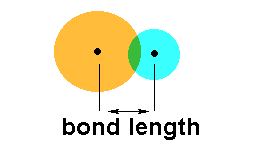How many miles are in a single gram of hydrogen cyanide?
1 Answer
I got
First, we assume that all molecules of
#R_("H","atomic") = "52.9 pm" = 5.29xx10^(-11)# #"m"# #R_("N","atomic") = "56.0 pm" = 5.60xx10^(-11)# #"m"# #r_("C"-"H","HCN") = "106.4 pm" = 1.064xx10^(-10)# #"m"# #r_("C"-="N","HCN") = "115.6 pm" = 1.156xx10^(-10)# #"m"#
Note that bond length is defined as the internuclear distance. That's why we don't need the atomic radius of carbon---that is already accounted for by the two bond lengths.

So, the length of one molecule of
#l_"HCN" ~~ R_("H","atomic") + r_("C"-"H","HCN") + r_("C"-="N","HCN") + R_("N","atomic")#
#= 5.29xx10^(-11)# #"m"# #+# #1.064xx10^(-10)# #"m"# #+# #1.156xx10^(-10)# #"m"# #+# #5.60xx10^(-11)# #"m"#
#= 3.31xx10^(-10)# #"m"# (or about#"331 pm"# )
So now, we take a look at how many
#1 cancel"g HCN" xx cancel"1 mol HCN"/("1.0079 + 12.011 + 14.007" cancel"g HCN") xx (6.022xx10^(23) "molecules")/(cancel"1 mol")#
#= 2.23xx10^(22)# #"molecules HCN"#
So, the full length of this many molecules of
#l_"1 g HCN" = (3.31xx10^(-10) "m")/cancel"molecule HCN" xx 2.23xx10^(22) cancel"molecules HCN"#
#= 7.38xx10^(12)# #"m"#
and this length in miles of
#color(blue)(l_"1 g HCN") = 7.38xx10^(12) cancel("m") xx (100 cancel("cm"))/cancel"1 m" xx cancel"1 in"/(2.54 cancel("cm")) xx cancel"1 ft"/(12 cancel("in")) xx "1 mi"/(5280 cancel("ft"))#
#= color(blue)(4.59xx10^9)# #color(blue)("mi")#

